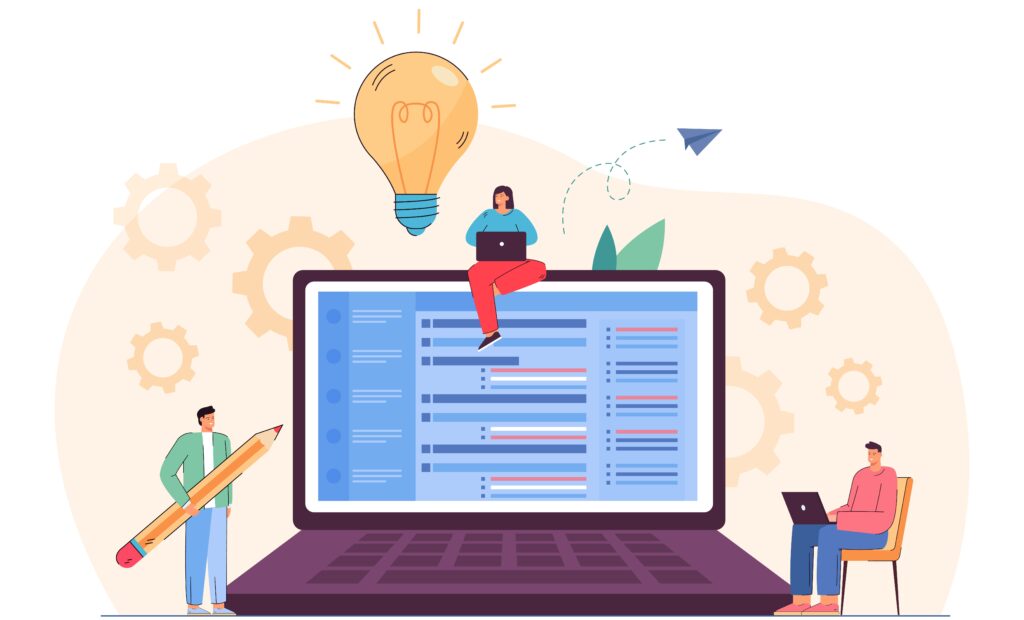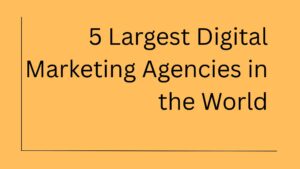The history of software is a tale of rapid innovation. Initially, software was crafted in complex machine code—binary instructions hard for humans to decipher. As technology evolved, higher-level languages like FORTRAN and COBOL made programming more accessible and efficient.
Today, the software development process is diverse and dynamic. Modern practices such as Agile and DevOps have revolutionized the process, focusing on iterative development, collaboration, and rapid feedback. These methodologies emphasize flexibility and responsiveness, allowing software to adapt swiftly to new requirements and deliver ongoing value.
This evolution from basic machine code to advanced development practices highlights the transformative journey of software. Explore our guide to understand how software has become essential in our lives and its critical role in technology and business.
Defining: What is Software?
Software, often known as computer software or simply “programs,” is the digital blueprint that brings electronic devices to life. Unlike hardware, which comprises the physical components of computers, smartphones, and other gadgets, software is the intangible set of instructions that makes these devices functional. It enables hardware to execute a wide range of tasks, from simple operations like word processing and data management to more complex activities such as gaming, web browsing, and running sophisticated applications.
Wherever you go, software acts as a bridge between the user and the hardware, translating user commands into actions and responses. It encompasses everything from operating systems that manage device resources to applications that cater to specific needs, like spreadsheets or video players. By understanding software’s role, you gain insight into how it shapes our digital experiences and drives the functionality of modern technology.
Key Characteristics of Software
Software has some essential traits that differentiate it from hardware and other technological elements. These characteristics also help explain its adaptability and importance in modern technology.
Written by People or Software Written by People
Software is fundamentally created by developers, engineers, and programmers. Although it can be generated with tools or by other software systems, it always originates from human design. A developer writes code, using various programming languages like Python, Java, or C++, which form the building blocks of any software program. This process involves problem-solving, logic, and creativity. The software development process often follows certain methodologies (such as Agile or Waterfall) to structure the work and ensure functionality.
In some cases, software can even generate other software. This includes code-generation tools and platforms that help developers automate aspects of coding, though the logic driving these tools remains written by humans. For instance, IDEs (Integrated Development Environments) or software like code generators can create templates, but the foundation of those tools still traces back to human effort.
Can Be Installed and Removed Without Physically Altering the Machine
One of the most defining qualities of software is its non-physical nature. Unlike hardware components that require physical manipulation (e.g., plugging in a new motherboard or adding RAM), software can be installed or uninstalled with relative ease. This is typically done through digital means—downloading, running an installer, or utilizing software management tools.
The installation process essentially involves transferring files to the system’s storage and setting up configurations to make the software run properly. Similarly, uninstalling software involves removing these files and cleaning up system settings. Because no physical hardware is altered during installation or removal, this flexibility makes software incredibly adaptable.
Can Be Updated Using Similar Techniques
Software is dynamic. Unlike hardware, which usually needs to be replaced for upgrades, software can be updated without any physical changes to the system. Updates typically come in the form of patches or new versions that are easily downloadable via the internet.
These updates can improve security, add features, or fix bugs that may have been present in previous versions. For instance, an operating system might receive monthly security patches, while an app might push frequent updates for better functionality or user experience. The process of updating software is straightforward, often requiring just a click or a few settings adjustments.
What Are the Components of Software?
Software is not a monolithic entity—it consists of various components that work together to deliver a functional product. These components help provide structure, organization, and interaction for the user experience.
Frontend
The frontend refers to the user-facing part of the software. It encompasses everything the user interacts with, including the graphical elements (such as buttons, menus, and icons). Frontend development typically involves technologies like HTML, CSS, and JavaScript, which are used to create websites or mobile app interfaces.
For example, the layout of a website or the user interface of a mobile app is the frontend, designed to be intuitive and user-friendly.
Backend
The backend of software is the part that users don’t interact with directly. It handles the data processing, business logic, and storage. The backend typically involves a server, database, and APIs to manage data flow and ensure the proper functioning of the application.
For example, in an e-commerce app, the backend would handle customer data, product inventories, and order processing.
Database
Databases are critical for storing and organizing data within software applications. A database allows for efficient retrieval and management of information. For instance, a social media app like Instagram stores user profiles, posts, and comments in a database, allowing quick access and updates.
Popular databases include MySQL, MongoDB, and PostgreSQL.
APIs (Application Programming Interfaces)
APIs enable communication between different software systems. An API specifies how software components should interact, allowing them to share data and functionality. For instance, a weather app might use an API to fetch weather data from a third-party service. APIs are essential in creating integrated software solutions across platforms and devices.
Types of Software Applications
Software can be broadly categorized into two main types of software, each serving distinct purposes within a computing environment. Understanding these classifications provides a clearer picture of the variety of software available and its intended use.
First Classification: Functional Categories
This classification breaks software into two primary categories based on their functionality—system software and user software.
System Software:
System software serves as the foundational layer between the hardware and application software. It controls and manages the hardware resources of a computer or device, making it possible for application software to run. Key examples of system software include:
- Operating Systems (OS): These are the most fundamental type of system software. Popular operating systems like Windows, macOS, and Linux handle essential functions such as memory management, file management, and controlling input/output operations. They also provide a user interface (UI) that allows individuals to interact with the device.
- Programming Environments (IDE): Integrated Development Environments (IDEs) provide developers with the tools to write, test, and debug their code. Examples include Visual Studio Code, Eclipse, and Xcode.
User Software (Application Software):
This category includes software that end-users interact with to complete specific tasks. Application software is designed for a particular purpose, whether that’s creating a software design document, editing a photo, or managing emails. Examples include:
- Web Browsers: Chrome, Firefox, Safari
- Office Software: Microsoft Office Suite (Word, Excel, PowerPoint)
- Multimedia Software: Video players like VLC, photo editors like Photoshop
Second Classification: Software by Delivery or Purpose
This classification divides software based on distribution models and specific uses, ranging from packaged software to cloud-based solutions.
- Packaged or Standard Software: These are commercially sold or licensed products designed for general or business use. Examples include Microsoft Windows, Microsoft Office, or enterprise software like SAP.
- Open Source Software: Open-source software is available for free, with its source code accessible for modification. This category includes programs like Linux, Apache Server, and Mozilla Firefox. The open-source community thrives on collaboration, where anyone can contribute improvements.
- Enterprise Software: These programs are designed to address the needs of organizations, ranging from small businesses to large enterprises. Examples include ERP (Enterprise Resource Planning) systems like SAP, CRM (Customer Relationship Management) systems, and more.
- Embedded Software or Firmware: This software is tightly integrated into hardware devices like smartphones, microwaves, and televisions. It allows the device to function but is not visible to end users.
- Cloud-Based Software: Cloud software runs on remote servers and is accessed over the internet. Examples include Microsoft 365, Google Workspace, and other cloud platforms that don’t require installation on local devices.
- Web Applications: These software programs run within a browser and are often used for activities like communication, collaboration, and entertainment. Examples include Gmail, Facebook, and Google Docs.
Third Classification: Licensing Models
Software licensing models provide another way to classify software based on how it’s distributed and priced.
- Free Software (Freeware): Software that is available for free download and use, with no charge for the software itself. Examples include Mozilla Firefox, VLC Media Player, and GIMP.
- Open Source Software: Open-source software is both free and modifiable, allowing users to access the source code. Linux and OpenOffice are prime examples.
- Public Domain Software: This software has no copyright restrictions and can be freely used, modified, and distributed. For instance, older software released into the public domain allows complete freedom for adaptation.
- Shareware: Software that is free for a limited time or with reduced functionality. After a certain period, users are expected to purchase the full version. Examples include WinRAR and WinZip.
- Commercial Software (Proprietary Software): Software that requires a paid license for use. Proprietary software is often closed-source and has limitations on modification. Examples include Adobe Creative Cloud, Microsoft Office, and AutoCAD.
Common System Software Examples
To understand how system software operates, here’s a more detailed look at key examples and their roles in maintaining the system’s operations.
Operating System (OS)
The operating system is the most critical system software on any device, as it manages the computer’s resources (such as CPU, memory, storage, and peripheral devices). The OS ensures that all other software programs run smoothly by providing a user interface and managing system hardware. For instance, Windows 10 offers a graphical interface and manages applications running in the background.
An OS can be designed for specific use cases such as real-time operating systems used in embedded devices, or mobile operating systems like Android and iOS, which manage smartphones and tablets.
Device Drivers
Device drivers are small programs that facilitate communication between the operating system and hardware peripherals. Without the appropriate drivers, devices like printers, sound cards, or graphics cards cannot function correctly. For example, a printer might require a specific driver to enable the OS to send print commands to it.
Firmware
Firmware is a specialized type of software embedded in hardware devices, often stored in non-volatile memory. It controls the hardware’s basic functions and can’t be easily modified like regular software. An example is the firmware in a smart thermostat that controls its interactions with sensors and Wi-Fi networks.
Programming Language Translators
Programming language translators are crucial for converting code written in high-level languages into machine-readable instructions. This enables software to be executed on a computer. There are three main types of translators:
- Compilers: Convert the entire program into machine code at once.
- Interpreters: Translate and execute code line by line.
- Assemblers: Convert assembly language into machine code.
Utility Software
Utility software helps maintain and optimize the computer system. It assists with functions like file management, security, and system cleanup. Utilities can include antivirus software, backup programs, disk cleanup tools, and file compression software like WinRAR.
Application Software
Application software is what users interact with directly. These software programs allow users to complete specific tasks such as creating documents, sending emails, or editing photos. Examples of application software include productivity tools like Microsoft Word, spreadsheet tools like Excel, email clients like Outlook, and media software like VLC Media Player.
Software System Licensing and Distribution
Understanding the different software licensing and distribution models is key to navigating today’s technology landscape. Here’s a breakdown of the major types:
Proprietary Software
Proprietary software is owned and controlled by a specific company or individual. Users must purchase a license to use the software, adhering to the terms and conditions set by the owner. This model includes widely recognized software like Microsoft Windows, which users buy and install on their devices. The source code of proprietary software is kept secret, and any modifications or redistribution are typically prohibited. This model ensures the software developer retains control over its use and distribution.
Open-Source Software
In contrast, open-source software is available for free, with its source code open to the public. This model encourages transparency and collaboration, allowing users to inspect, modify, and enhance the code. Notable examples include the Linux operating system and the Apache web server. Open-source software fosters innovation by enabling a community of developers to contribute to and improve the software, making it highly customizable and adaptable to various needs.
Software as a Service (SaaS)
The Software as a Service (SaaS) model represents a modern approach to software distribution. Instead of purchasing and installing software locally, users subscribe to cloud-based applications accessible via the internet. Popular SaaS offerings include Salesforce, which provides customer relationship management tools, and Dropbox, which offers cloud storage solutions. SaaS simplifies software access and management, as updates and maintenance are handled by the service provider. This model provides flexibility, scalability, and ease of use, making it a preferred choice for many businesses and individuals.
Each licensing and distribution model has its advantages and caters to different user needs, from the control and security of proprietary software to the flexibility and community-driven innovation of open-source and SaaS solutions.
The Role of Software Programs in Modern Society
Software’s impact on modern society is profound and pervasive, shaping nearly every aspect of our daily lives. From the moment we wake up to the sound of an alarm clock app to the navigation software that directs us through traffic, software is seamlessly integrated into our routines. It manages our schedules, connects us with friends and family, and even entertains us through streaming services and games.
In the business realm, software is equally crucial. It transforms how companies operate by automating repetitive tasks and streamlining complex processes. For instance, customer relationship management (CRM) software helps businesses build and maintain strong relationships with their clients by tracking interactions and providing valuable insights. This leads to enhanced customer service and more effective marketing strategies.
Additionally, Enterprise Resource Planning (ERP) software plays a critical role in optimizing resource allocation and supporting decision-making. It integrates various business functions—such as finance, human resources, and supply chain management—into a cohesive system, improving efficiency and strategic planning.
The Future of Software
The future of software holds exciting prospects. Artificial intelligence (AI) and machine learning (ML) are poised to revolutionize software capabilities, enabling systems to learn and adapt autonomously. Augmented reality (AR) and virtual reality (VR) applications are advancing rapidly, creating immersive experiences. Quantum computing, still in its infancy, promises unprecedented computational power.
Hence, software is the digital lifeblood of our interconnected world. Its influence spans from personal devices to global enterprises, shaping how we work, communicate, and entertain ourselves. Understanding its evolution, distribution models, and future trends is vital for individuals and businesses navigating the ever-changing digital landscape.
Conclusion
Software is the heart of any device, transforming hardware into a powerful tool for a wide range of tasks. Whether you’re running an operating system, playing a game, or using a productivity app, software is the driving force behind it all. By understanding its characteristics, types, and components, we gain a better appreciation for how software shapes our digital experiences and continues to evolve as technology advances.
Software related FAQs
System software is essential for the operation of the hardware and provides a platform for running application software. It includes the operating system, device drivers, and utility software, which manage and control hardware resources. Application software, on the other hand, is designed for end users to perform specific tasks, such as word processing, web browsing, or image editing. While system software is typically invisible to the user, application software is directly interacted with, allowing users to complete everyday tasks.
While both firmware and embedded software run on hardware, their roles differ significantly. Firmware refers to low-level software that is permanently programmed into a device, such as the code embedded in a printer or microwave. It provides basic control and functionality for the device’s hardware. Embedded software, however, is typically more complex and designed for specific tasks in devices like smart TVs, cars, or medical equipment. Unlike firmware, embedded software can be updated and might provide more extensive functionality beyond basic device operation.
Cloud-based software operates through the internet, allowing users to access programs and data stored on remote servers, rather than on their own devices. This allows for easier collaboration, instant updates, and flexibility across multiple devices. However, it requires a reliable internet connection for optimal performance. In contrast, traditional desktop software is installed directly on a user’s computer or device, making it independent of internet access (although some functionality might be enhanced with online features). While desktop software often runs faster and more efficiently without network dependency, it typically lacks the scalability and convenience of cloud-based alternatives.
Open-source software plays a crucial role in fostering collaboration, innovation, and transparency in the software ecosystem. Unlike proprietary software, open-source software allows developers to access, modify, and distribute the source code. This has led to the creation of robust and cost-effective solutions, such as the Linux operating system or the Firefox browser, that have become integral parts of the digital landscape. Open-source software also promotes community involvement, where developers from all over the world can contribute to improving the software, ensuring it stays up-to-date and secure.






1 thought on “What is Software? Insights into Its Definition, Types, and Roles”
We are a group of volunteers, and we are starting a new scheme in our software community. Your website provided us with valuable information to work on. You have done a splendid job, and our whole community will be thankful to you for writing all things together, including software and e-commerce technology. Expecting you to cover further more than I mentioned here. Thanks again!